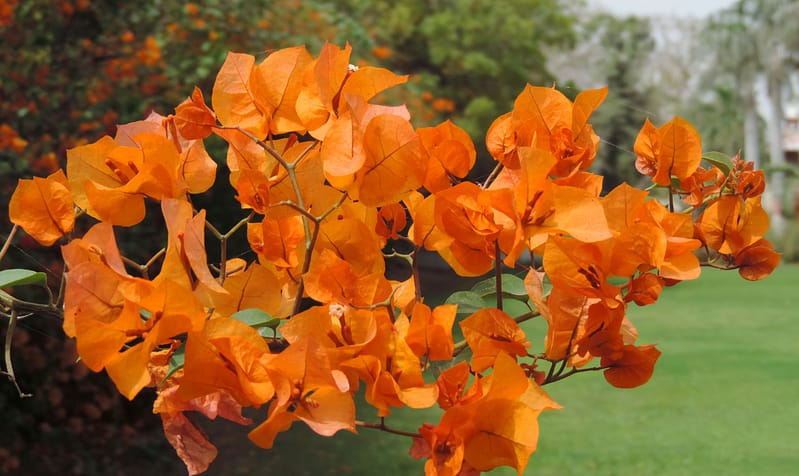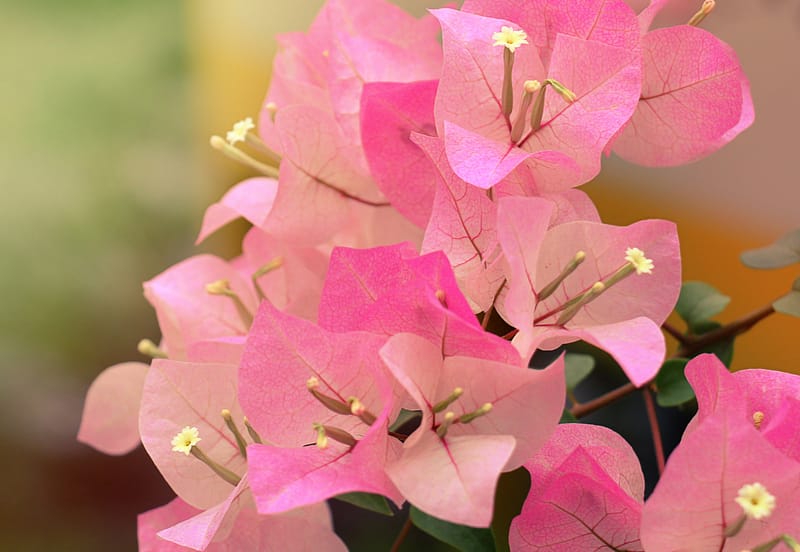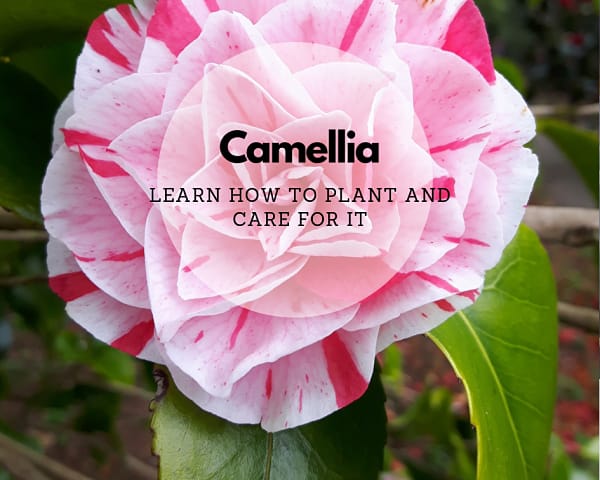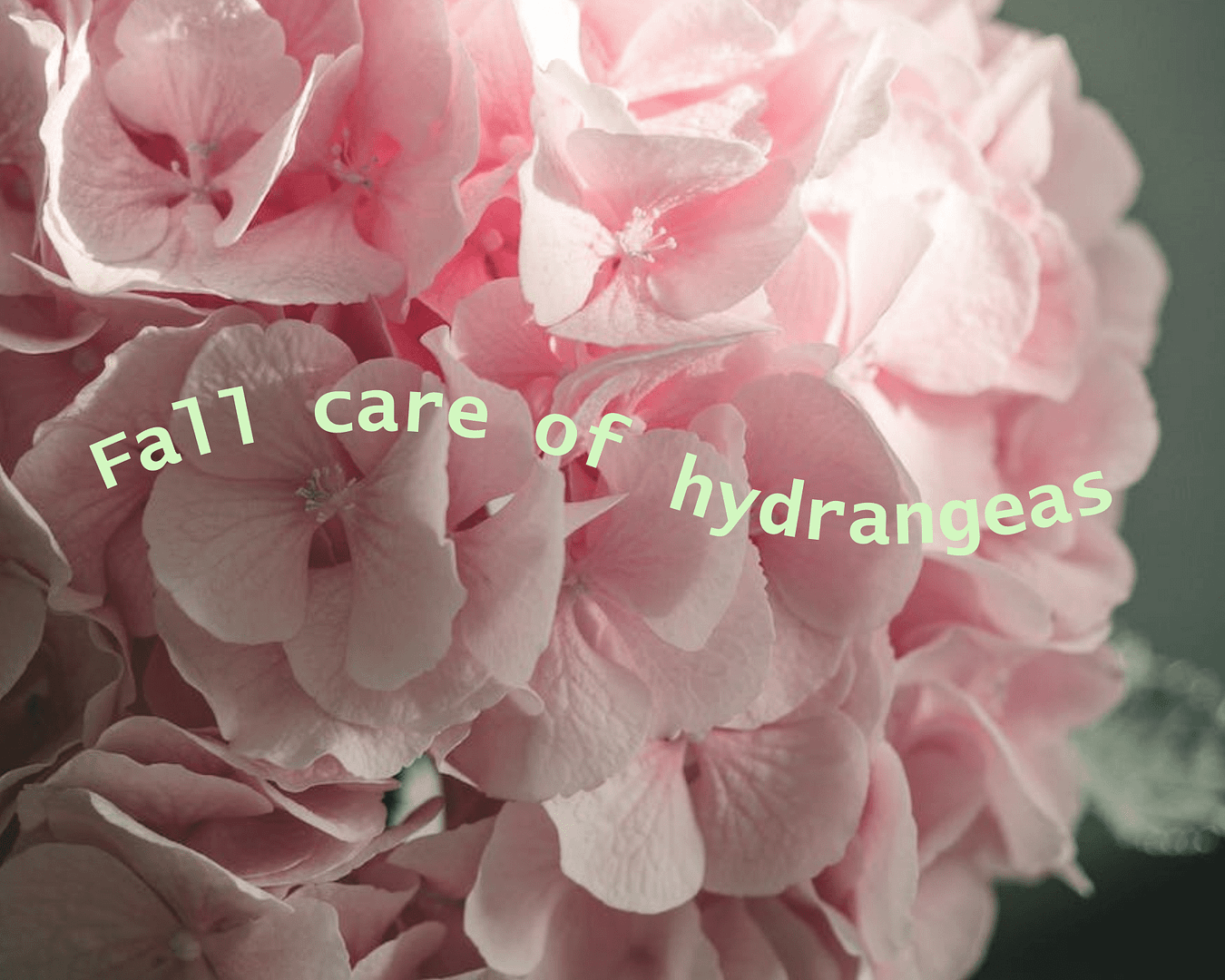This post may contain affiliate links. As an Amazon Associate we earn from qualifying purchases.
Bougainvillea problems are typically the gardener’s fault. Sound harsh? While the plant is, overall, an easy and versatile grower, it does have some diva-like qualities that, unfortunately, many aren’t aware of.
Native to parts of South America, many gardeners have a love/hate relationship with the über-gorgeous but rather thorny bougainvillea (Bougainvillea spp.).
Oh, and in case you’re curious, her name is pronounced “boo·gen·vil·ee·uh,” with a soft “g” and emphasis on the third syllable.
The boug (as many of its growers call it) loves the heat and despises the cold. Its official USDA hardiness zones are 9b and above.
Remember, these zones only describe a plant’s cold hardiness. If you have warm to hot summers it will certainly do well, provided you protect it in the winter in, say, zone 8,
Outside of its hardiness zones, the bougainvillea may go dormant in winter. Don’t be alarmed and think it has kicked the bucket.
To see it again in spring or summer, winterize it by piling a thick layer of mulch over the rootzone.
Also, be aware that some species take longer to leaf out when the weather warms. Many new growers assume it’s dead. Don’t be quick to toss it.
Find your growing zone right here.
Why is my bougainvillea not flowering?
This is probably the number one question we field from new bougainvillea growers. And for good reason: we grow bougainvillea for the color it adds to the landscape. Failure to bloom is just not acceptable, right?
There are several reasons that your boug may not be flowering. So, let’s take a look at the most common.
 Bougainvillea requires lots of sunlight
Bougainvillea requires lots of sunlight
“Bougainvillea needs at least six hours of direct sunlight each day to bloom,” or so say some of the gardening “experts” online.
Hogwash.
Yes, there are some varieties that need more sun than others and, no, your boug will not bloom in the heavy shade of an African sumac or oak tree.
I have two that live in pots and bloom in the partial shade on my covered patio. It’s not a profuse bloom like you’d see in a gardening mag, but bloom they do and I love it.
That said, for optimal growth and bloom, my bougainvillea in direct sun for most of the day give me the most flowers.
 Improper or no pruning
Improper or no pruning
- Bougainvillea problems may occur due to improper pruning or the timing of when you prune. It is a critical task to help the bougainvillea give up those gorgeously colored bracts.
- Bougs flower on new growth and new growth is produced by pinching branch tips and pruning.
- Depending upon the growth rate of your particular bougainvillea, pruning can be done at any time of year. If it’s a slow grower, however, and you decide to prune late in the season, don’t expect it to flower on that new growth until next season. It may flower soon, but don’t be disappointed if it doesn’t.
- Pinching should be done after a blooming cycle or shortly before it ends. Just pinch the tips of soft branches to produce additional branching and, thus, more flowers.
 Bougainvillea problems: Over-fertilization
Bougainvillea problems: Over-fertilization
- While nitrogen is important to bougainvillea flowering, too much of it will give you lots of foliage and few blooms.
- Get around this problem by using a controlled-release fertilizer which will help “… moderate nitrogen release,” according to the experts at the University of Hawai’i at Manoa.
- Then, twice a year, ward off some common micronutrient deficiencies (such as iron and magnesium) with a “… complete micronutrient blend …” (University of Hawaii).
- Because an excess of either iron or magnesium can cause a deficiency in the other, use caution. Use it a maximum of twice a year (only if needed) and at half the rate recommended on the product’s label.
 Bougainvillea thrives on stress
Bougainvillea thrives on stress
Handling heat, draught (when it’s established) and blazing sun is all in a day’s work for our pal, the boug.
That said, too much or too little of any of these can cause failure to bloom.
Heat, even reflected from a concrete wall, isn’t typically a problem for the established bougainvillea.
- Is it thirsty? The fastest way to kill this plant (aside from rough handling when transplanting it) is to overwater it. Keep an eye on the bougainvillea’s foliage. If it begins to wilt, it needs water.
- Overall, when you water, ensure that you soak the root ball and then allow the soil to dry almost completely. I always wait for the wilt. Don’t allow it to wilt for a prolonged period, though. This is a stress sign and all will be well if you promptly give it water.

The days just aren’t short enough
Here’s a word for you: photoperiodism.
No, that doesn’t mean that some bougainvillea species are camera shy. Photoperiodism describes the way a plant responds to day length.
There are plants that require long days, such as those we experience in summer. The group of long day plants includes petunia, spinach, chrysanthemums and hibiscus, among others.
Then there are day-neutral plants. These guys don’t care about day length and the group is vast.
Then, there are the short day plants, such as some bougainvillea, that won’t bloom until the days get shorter.
Although it’s common knowledge among well-read botanists, most home growers have no idea if they own a short-day bougainvillea. Most think they got stuck with a dud or that they’re terrible at gardening.
“Bougainvillea x buttiana cultivars are mostly considered qualitative short-day plants that flower more readily and profusely under short day lengths,” according to Mun Wye Chng and Kimberly A. Moore, researchers with the University of Florida, IFAS, Fort Lauderdale Research and Education Center.
I have an ‘Imperial Thai Delight’, which is a Bougainvillea x buttiana. It is now August, as I write this and it hasn’t bloomed and won’t until probably late September or October.
In fact, researchers claim that all Bougainvillea species exhibit photoperiodism, with some periods longer than others.
Why are my bougainvillea leaves turning yellow/brown?
- Common among bougainvillea problems is the yellowing or browning of leaves. This can be a sign of several issues, including overwatering, nutrient deficiencies, or pest infestations.
- Overwatering is a common problem, as bougainvillea prefers slightly dry conditions. Make sure the soil has good drainage and avoid watering too frequently.
- Nutrient deficiencies, particularly iron or magnesium, can also cause yellowing leaves.
- A common symptom of a potassium deficiency in bougainvillea is browning of the edges of the leaves. Typically, only older leaves are impacted, which should help you distinguish between this deficiency and fertilizer burn. See the section on fertilizing, above to get tips on curing this.
- Spider mite infestations impact the boug’s foliage as well so inspect it routinely for pests.
- Getting the right amount of water at the right time will ensure that your bougainvillea’s leaves remain healthy. Allow the soil to dry out between waterings. If the plant begins to wilt, water it.
- Overwatering can lead to root rot, which also causes yellowing leaves. If you suspect root rot, reduce watering and improve drainage.
- If you remember nothing else about bougainvillea care, remember this: they don’t handle root disturbance. Too much will throw the plant into shock and result in the loss of leaves. Transplant the bougainvillea quickly and gently and keep it slightly shaded until it establishes.

Container-grown bougainvillea
Growing bougainvillea in containers presents its own set of challenges. Here are some problems specific to container-grown bougainvillea and how to address them.
Root-bound plants: Bougainvillea has an extensive root system and can quickly become root-bound in a container. When this happens, the plant’s growth may slow, and it may produce fewer flowers.
To prevent this, choose a large container and consider repotting your bougainvillea every couple of years.
Watering issues: Container-grown plants are more prone to watering issues, as they can dry out more quickly than in-ground plants.
Ensure your container has good drainage and water thoroughly when an index finger inserted into the soil comes out dry. Avoid letting the container sit in water, as this can lead to root rot.
Temperature fluctuations: Containers can expose the roots to more significant temperature fluctuations than in-ground planting. In hot weather, the soil in containers can heat up quickly, causing stress to the plant.
In cold weather, containers offer less insulation against the cold. Consider placing your container in a location that provides some protection from extreme temperatures, such as near a wall or under a canopy. Oh, and pile up the mulch as high as possible over the root zone.
 Interested in growing Bougainvillea? Check out the most common species and hybrids
Interested in growing Bougainvillea? Check out the most common species and hybrids
There are four commonly grown species of bougainvillea, each with its unique characteristics. Understanding these species can help you choose the right one for your garden.

Bougainvillea glabra: Also known as paper flower, this species is known for its smooth leaves and thorny stems. It is a vigorous grower and can be trained to climb trellises or walls. It is slightly smaller than the others, however, making it ideal for container growing.
If variegated foliage is what you’re after, in addition to gorgeous flowers, check out the glabra hybrid ‘Raspberry Ice.’ Despite its name, it is quite sensitive to frost.
‘Magnifica’ has rose pink bracts.
‘Snow White’: Creamy white bracts
Bougainvillea spectabilis: This species is known for its large, hairy leaves and strong, woody stems. It is often grown as a sprawling shrub or vine and produces an abundance of colorful bracts.

Bougainvillea peruviana: This species is less common but is prized for its smaller size and more compact growth habit. It has slender stems and smaller leaves, making it suitable for smaller gardens or containers.
‘Barbara Karst’ (shown above), one of the most popular bougainvillea plants, is a hybrid between B. glabra and B. puruviana.

Bougainvillea x buttiana ‘Thai Delight’
Bougainvillea buttiana: A hybrid of Bougainvillea glabra and Bougainvillea peruviana, this species combines the best qualities of both parents. It has vibrant bracts and can be trained as a vine or pruned into a bushy shrub.
Gardeners outside of the plant’s hardiness zones may want to consider the ‘Barbara Karst’ (Bougainvillea x buttiana ‘Barbara Karst’) as it is thought to be among the hardiest of all bougainvillea.
Feel free to drop your questions in the comment box, below and we’ll get them answered!






